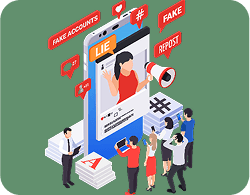How to Leverage Influencer Marketing for Your Brand’s Growth
Influencer marketing has become a go-to strategy for brands aiming to expand their reach, enhance credibility, and connect with niche markets. By collaborating with influencers who already have established audiences, businesses can achieve authentic engagement and drive conversions.


Understanding Influencer Marketing
Influencer marketing involves partnering with individuals who have built credibility and a loyal following within a specific niche. These influencers promote products or services to their audience, creating a ripple effect that enhances brand exposure and trust.
Types of Influencers
- Mega-Influencers: These are typically celebrities with millions of followers. They have the potential for vast reach, but engagement can be lower, and costs are higher.
- Macro-Influencers: These influencers have between 100,000 to 1 million followers. They usually specialize in a certain niche and are known for higher engagement than mega-influencers.
- Micro-Influencers: With 1,000 to 100,000 followers, micro-influencers tend to have a closer, more engaged relationship with their audience. They’re often seen as highly credible and authentic within their niche.
- Nano-Influencers: These are individuals with under 1,000 followers. They are hyper-niche and have a strong influence within very small communities.
Benefits of Influencer Marketing
- Enhanced Trust: Audiences trust influencers, especially when they share genuine opinions about products.
- Increased Reach: Influencers introduce your brand to new audiences who may not yet be aware of it.
- Higher Engagement: Because followers feel connected to influencers, they’re more likely to engage with content that features brands they recommend.

Setting Clear Goals for Your Influencer Campaign
Before diving into influencer marketing, clarify your objectives. Your goals will guide you in selecting the right influencers, crafting content, and measuring success.
Common Influencer Marketing Goals
- Brand Awareness: Increase visibility and recognition within your target audience.
- Engagement: Drive likes, comments, shares, or website visits through engaging influencer content.
- Lead Generation: Capture contact information from potential customers interested in your product.
- Sales: Increase conversions directly through influencer promotions or discount codes.
- Community Building: Foster a community around your brand by engaging with an influencer’s loyal audience.
Finding the Right Influencers for Your Brand
Choosing the right influencer is crucial to campaign success. You need someone whose values, aesthetic, and audience align with your brand.

Identify Relevant Influencers in Your Niche
Use social media, influencer platforms, or hashtag searches to find influencers who align with your brand.

Analyze Their Engagement Rates
Follower count alone doesn’t tell the full story. Check engagement rates (likes, comments, shares) to gauge the influencer’s connection with their audience...

Assess Content Quality and Authenticity
Review the influencer’s content to ensure it aligns with your brand’s aesthetic and values. Avoid influencers who appear overly promotional .

Check for Audience Alignment
Look at the influencer’s audience demographics to ensure they match your target audience in terms of age, location, interests, and values.
Crafting a Strong Influencer Marketing Strategy
Once you’ve identified your goals and chosen influencers, it’s time to plan your campaign’s approach and structure.

Define the Campaign’s Message and Theme
Decide on a central message or theme that conveys your brand values and resonates with the influencer’s audience. A consistent theme across posts will create a cohesive campaign.
- Example: A skincare brand could promote self-care with a “Pamper Yourself” theme, where influencers share their skincare routines using the brand’s products.

Choose the Right Content Formats
Work with influencers to determine which content format will be most effective for the campaign.
- Photos and Videos: Ideal for Instagram and Facebook, as visuals can highlight your product’s features.
- Stories: Great for behind-the-scenes or limited-time offers; ideal for building excitement.
- Live Streams: Highly engaging and personal, allowing influencers to showcase products in real-time.
- Blog Posts: Long-form reviews on a blog can provide in-depth details about your product and improve search engine visibility.

Decide on Payment and Incentives
Work with influencers to determine which content format will be most effective for the campaign.
- Photos and Videos: Ideal for Instagram and Facebook, as visuals can highlight your product’s features.
- Stories: Great for behind-the-scenes or limited-time offers; ideal for building excitement.
- Live Streams: Highly engaging and personal, allowing influencers to showcase products in real-time.
- Blog Posts: Long-form reviews on a blog can provide in-depth details about your product and improve search engine visibility.

Executing the Campaign
Collaborating with influencers effectively requires open communication and clear expectations.
Create a Campaign Brief
Prepare a brief that outlines the campaign’s goals, target audience, key messages, content guidelines, and any brand-specific requirements. Include preferred hashtags, visual styles, and any calls to action you’d like included.
- Example: A fashion brand might specify that the influencer showcase specific items in a unique outfit, using #StyleWith[Brand] for consistency.
Encourage Authenticity
Allow influencers the creative freedom to represent your product in their own style. Authenticity resonates with audiences and avoids the impression of a scripted advertisement.
Establish Posting Schedules
Work with influencers to establish a timeline for posts. Schedule them strategically around peak engagement times or campaign phases.

Measuring Success and ROI
A one-off collaboration can be effective, but building long-term relationships with influencers can lead to even greater results. Loyal influencers can become brand ambassadors, promoting your products regularly and fostering an ongoing relationship with their audience.
Nurture Repeat Partnerships
If an influencer’s first collaboration was successful, consider working with them again. Audiences often respond well to seeing familiar faces, creating a sense of consistency and credibility.
Develop Brand Ambassadors
Consider establishing a brand ambassador program, where select influencers promote your products over a longer period. This can build stronger connections between the influencer and your brand.
Offer Exclusive Perks
Offer influencers exclusive perks, such as early access to new products, discounts, or invitations to brand events. These gestures help solidify the relationship and demonstrate that you value their role in your brand’s growth.

Building Long-Term Relationships with Influencers
A one-off collaboration can be effective, but building long-term relationships with influencers can lead to even greater results. Loyal influencers can become brand ambassadors, promoting your products regularly and fostering an ongoing relationship with their audience.
Nurture Repeat Partnerships
If an influencer’s first collaboration was successful, consider working with them again. Audiences often respond well to seeing familiar faces, creating a sense of consistency and credibility.
Develop Brand Ambassadors
Consider establishing a brand ambassador program, where select influencers promote your products over a longer period. This can build stronger connections between the influencer and your brand.
Offer Exclusive Perks
Offer influencers exclusive perks, such as early access to new products, discounts, or invitations to brand events. These gestures help solidify the relationship and demonstrate that you value their role in your brand’s growth.

Staying Compliant with Disclosure Guidelines
Transparency is essential in influencer marketing. Ensure that influencers clearly disclose any paid partnerships or sponsored posts in accordance with the Federal Trade Commission (FTC) guidelines or applicable regulations in your region.
Use Clear Disclosure Tags
Ask influencers to use tags like #Sponsored, #Ad, or “In Partnership with [Brand]” to make the collaboration transparent. This ensures compliance and maintains the trust of both their followers and your audience.

Conclusion
Influencer marketing offers brands a powerful way to expand their reach, build credibility, and engage niche audiences. By setting clear goals, choosing the right influencers, and focusing on authentic collaborations, you can create campaigns that drive real results for your brand’s growth. With careful planning and a commitment to long-term relationships, influencer marketing can become a valuable, ongoing part of your marketing strategy.
